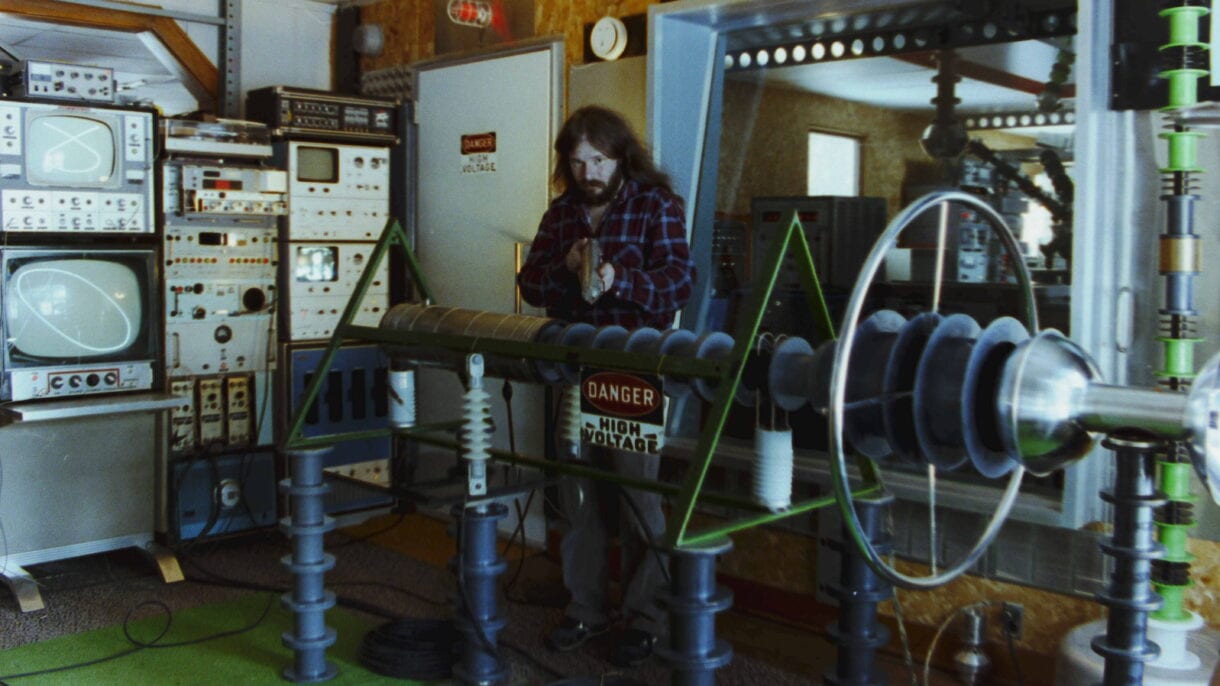John Shepherd beamed music into space from his grandparents’ cottage in Northern Michigan for 26 years. Dedicating himself to this singular passion project, he hand built a collection of tracking and transmitting equipment that became so large it spilled out from his bedroom into the living room, eventually requiring an addition to the house. The expansive sounds Shepherd selected for broadcast from his collection of 4,000 records—Afrobeat, krautrock, new age, jazz, dub, and gamelan—were just as carefully assembled, showcasing the most beautiful compositions that humans from across the globe had to offer. As he has said, “I sent music into space because it represents a certain universal language.” “By not having to work 40 hours a week, I had more time and freedom to be creative,” Shepherd says over the phone from his home 250 miles north of Detroit. “I rented rooms in the house and did any kind of odd jobs I could to support my project. It’s something that not everybody does, I admit that. But if it could be an inspiration for others, that’s kind of beautiful, I think.”

Shepherd is the subject of John Was Trying to Contact Aliens, a deeply heartfelt 16-minute documentary by director Matthew Killip that took home Sundance’s 2020 Short Film Jury Award and is now available on Netflix. It’s not the first time Shepherd has been given a spotlight for his work with Project STRAT (Special Telemetry Research and Tracking). Since the project launch in 1972, Shepherd has been featured in books, magazine articles and on national TV such as The Joan Rivers Show, where he joined a panel of fanatical Fox Mulder-like believers. What sets Shepherd apart from other UFO chasers is his patient devotion to the process of building a DIY NASA. Gathering materials from surplus sites and utility companies, he assembled a vast array of cabinets, consoles and circuit boards. With help from his machinist grandfather, these were transformed into state-of-the-art devices such as oscillators, giant screens and cathode ray tubes that became space blasters aimed into the outer limits. At first, Shepherd’s pirate broadcasts (such as the 1996 episode Space Cruise 1, above) were sent out on an ultra-low frequency through a radio tower conveniently located on his grandparents’ front yard. Listening to him lovingly describe the soothing sounds of Channel Light Vessel, a ’90s experimental supergroup featuring Brian Eno’s brother Roger, proves the depths of Shepherd’s knowledge. His heady tastes have endeared him to earthly music fans as well. With the support of his grandmother Irene’s life savings, Shepherd says in the documentary that he “completed the project” by constructing a two-story accelerator unit partially made from a dismantled ski lift in a glass-encased laboratory connected to the house. Pumping up to 150,000 volts allowed his music to be sent millions of miles into space to a prospective audience of extraterrestrials. Midway through the film, Shepherd reveals that growing up gay in the rural Michigan of the early 1960s heightened his sense of alienation. He says his attraction to men was instinctive from a young age, but he didn’t have a serious boyfriend until much later in life. Moving in with his grandparents had been the solution to a troubled childhood with an emotionally distant mother and a father who left shortly after Shepherd’s birth. Committing every waking moment to Project STRAT gave his life purpose. He dreamed of learning about alien technology that could be passed on to what he calls “non-warlike intel people [who] probably exist somewhere.” At the same time, he never gave up hope that there was someone to connect with romantically on his home planet. “I’ve been interested in UFO culture for a long time, but not particularly about whether or not they’re real,” says director Matthew Killip, whose previous short film subjects include lichens, diatoms and cryptozoology. “The dangerous thing about documentaries on people who are interested in UFOs is that it can paint them as eccentric weirdos without going anywhere besides slightly making fun of them. That’s not the kind of film I was interested in making whatsoever. “When I heard the details of John’s life, I realized it was a beautiful story,” Killip continues. “You can place UFOs in a religious or metaphysical framework, with humans looking outside of themselves. John’s story really goes there for me. He’s trying to touch something beyond himself, and that’s very moving.” To celebrate his birthday in 1993, Shepherd ventured out to a gay bar called Side Traxx in nearby Traverse City. Though dressed in his finest leather hat and pants, he didn’t feel like joining the more outgoing patrons on the dance floor. However, Shepherd did notice another bearded man standing on the sidelines. Sensing a compatibility with a fellow observer, he screwed up his courage and introduced himself. “The first thing that came out of my mouth was, ‘What do you think about Ornette Coleman?’” Shepherd laughs. “We started talking about avant-garde jazz and just hit it off. He was most attractive, I must say, and still is. Maybe it was my inner sense or empath quality that there was something special about this person. He’s not like the rest of them.” The first time Shepherd invited the man, John Litrenta, to see Project STRAT, he was worried. Thankfully, Shepherd says, “he didn’t freak out like I was a Russian spy or an alien myself.” They continued to bond over a shared love of sci-fi shows like Dr. Who and The Man From U.N.C.L.E. In the documentary’s teary third act, photos from their wedding show them kissing in top hats alongside clips of them beaming at each other in the present day.

John Litrenta and John shepherd's wedding.
“When you see them together, you can’t help but feel hopeful about the human condition, that these two people found each other,” says Killip. “Any time you see an elderly couple who are affectionate, that gives you a warm feeling that it can work out. Humans can be together and get along. John and John are one of those couples that make you feel optimistic about love.” Since the film’s wide release on Netflix, viewers have wondered why a story this compelling wasn’t made into a full-length feature or series. Killip explains that his initial hope was for it to screen at festivals, but the documentary could have easily ended up simply living on his Vimeo page. Limiting it to 16 minutes is not only the short-form format he knows best, but allows him to capture the attention spans of “people who aren’t necessarily into Kraftwerk or UFOs” while keeping its narratives on track. It will hopefully be expanded in the future. “I don’t think I’m done with the story,” Killip says. “I’ve spent a long time thinking about John’s life and it resonates with me really deeply. There will be more to come on this at some point. I just need to figure out what that will be.” Due to a lack of funds, Project STRAT has sadly been shut down since 1998 and currently lives in storage. Of course, Shepherd remains keenly interested in his lifelong pursuit, making music of his own and creating sound effects of space crafts (he adds echo effects to a furnace blower). With renewed attention on his broadcasts from the documentary, he hopes to resume transmitting as a more traditional radio show or podcast. It should also come as no surprise that his living room is still packed with equipment, including synthesizers, six-foot tall racks of electronics and a massive subwoofer speaker typically found in movie theatres. “It’s so big that it holds up our dining room table,” Shepherd says. “It doesn’t take much to rattle the dishes on our shelves. When you’re watching a movie like Star Wars and play the sound through that subwoofer, you can feel it, boy!”


 Why you can trust Xtra
Why you can trust Xtra


